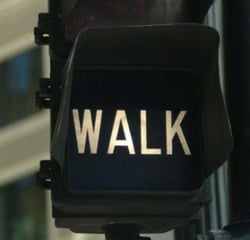 When we talk to clients about the value of Gemba Walks, we often hear, “Oh yeah, we do that. We just call it Management by Walking Around.” The assumption that the two are the same is common, but mistaken. Even Wikipedia gets it wrong when it says, “The term "Management by wandering around" or "MBWA" is also perceived to be comparable to going to the gemba.” Related? Perhaps (both involve walking), but comparable? Not at all.
When we talk to clients about the value of Gemba Walks, we often hear, “Oh yeah, we do that. We just call it Management by Walking Around.” The assumption that the two are the same is common, but mistaken. Even Wikipedia gets it wrong when it says, “The term "Management by wandering around" or "MBWA" is also perceived to be comparable to going to the gemba.” Related? Perhaps (both involve walking), but comparable? Not at all.
Different Goals
The goal of a Gemba Walk is to examine the current state of a particular process by observing it in action at the place where it occurs. This aim is narrow, focused and very specific. Management by walking around (MBWA), on the other hand involves seeing what’s going on more broadly (or, done badly, just saying hello and visiting people in the workplace).
Different Destinations
A Gemba Walk takes the manager or executive to a specific place to observe a particular activity. In other words, you know ahead of time where your Gemba Walk will take you and what the theme or focus will be. In management by walking around the destination is undefined by design.
Different Tactics
During a Gemba Walk, the manager asks very in-depth questions about the process being observed. Who is involved? What materials are used? What do you do? How do you know what to do? When does the task take place? What depends on the outcome? Management by walking around does not involve that degree of depth. Nor, does MBWA usually focus on asking open ended questions, as would a Gemba Walk.
In fact, Dr. W. Edwards Deming, often called the Father of Quality Evolution, said in his 1982 work, Out of the Crisis, “‘Management by walking around’ is hardly ever effective. The reason is that someone in management, walking around, has little idea about what questions to ask, and usually does not pause long enough at any spot to get the right answer.
Organizations that effectively use Gemba Walks will create structure. For example, ThedaCare has created "STAT sheets" that provide consistent questions to be used by leaders at each level. Leaders also spend time at the Gemba to make sure they better understand the work... but at the same time, they don't worry about become experts in the work, because they can rely on the insights and expertise of front-line staff.
Different Outcomes
Opportunities for improvement are identified, but generally aren't acted upon during a Gemba Walk. Managers who visit the Gemba tend to ask questions instead of giving answers.
Typically, a period of subsequent reflection and analysis occurs before any action is taken. This provides the opportunity for a fully formed “Plan, Do, Study, Act” cycle. There is no such limit when practicing management by walking around, so on-the-fly process changes are common, changes that are often half-baked and can be more disruptive than helpful.
We can’t say there is anything wrong with managers taking a stroll around the workplace from time to time, but management by walking around cannot take the place of a purposeful, well executed Gemba Walk.
Download this free guide to learn how to have Gemba Walks that actually result in improvement:



Add a Comment